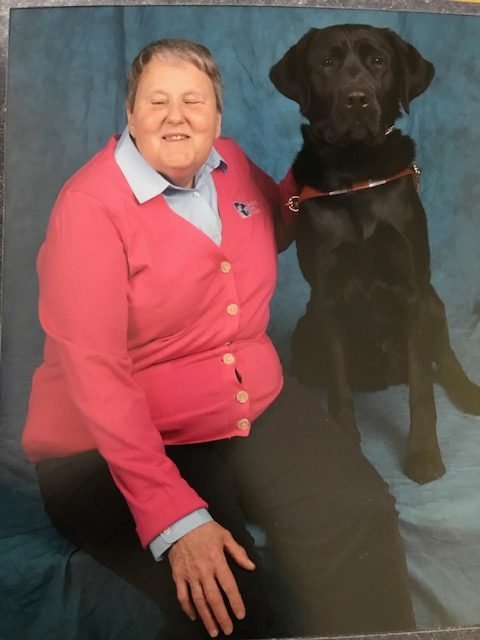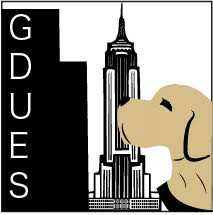Nancy Murray, GDUES founding Member and current president

Nancy and black lab, Nate
My Blindness was caused by too much oxygen as I was three months premature. Back in the mid-1940s when babies were born too early, they were given 100 percent oxygen and the baby’s eyes were not covered. My retinas were damaged and the optic nerve along with them, resulting in what is called retinopathy of prematurity, or ROP. Traveling with a guide dog is faster and safer than with a cane. With a cane that cane does not detect objects or obstacles like a guide dog does. You also walk in a straighter line than when you use a cane. I remember after I got my first dog, I used to say why did I wait so long and yes, I was amazed what the dog did that the cane did not. Even today when I have to use a cane, I hate it. I hope to use a guide dog as long as I am able to walk as they not only help me in traveling and getting around but are great companions.
I joined GDUES because I wanted to belong to a guide dog group that would support me if I had issues related to service dog denial in an establishment or transportation and access such as Uber or Lift. Also, as there was not a Guide dog affiliate of ACBNY in upstate New York I felt it was a great idea to establish one.
What is my opinion on transportation network companies and guide dog users since getting my first dog? When I got my first dog companies like Uber and LYFT did not exist in New York State. Now that I have my sixth dog, and even before this dog, transportation network companies like Uber and LYFT started in upstate New York in July 2017. I have been Denied once by a Lift driver who was a foreigner. I think a big problem why persons with guide dogs are refused rides is ignorance, and cultural differences, especially with persons who come from other countries. We as guide dog users need to educate these people.
I got my first guide dog in February 1984. I have had 6 dogs. Five of those dogs have either passed away or are retired. Currently my sixth dog is a big black lab and he keeps me on my toes. He is young and needs lots of attention and activity.
The bonding Process
Guide and service dogs are invaluable to the humans they assist. But their helpful behaviors aren’t in-born; the dogs must undergo extensive training before they’re able to serve as the eyes, ears and hands of the folks who need them.
First, a young dog, 8 to 10 weeks of age, goes to what is called a puppy home, remaining there until 13 to 15 months old. This is his family. He is given basic obedience training, goes to work, schools, businesses and medical facilities, and is taken on various modes of transportation.
Then, without being asked, the dog is removed, and put in a guide dog training school. His whole life has been turned upside down, so to speak. He adjusts, and once again is feeling at home when, four to six months later, he is given to a stranger, and expected to immediately bond with this person.
I recall my first weeks at the training school and my early days with my current guide dog, Randy. Our first few training walks were not so great; I would often return disheartened. But day by day the bond grew.
Several times on our early walks he would bump me against something, but I tried to ignore these. My trainer would say, “Ernie, correct him. The next time you may get hurt.” I didn’t want to give a leash correction, though I understood the value of correcting him.
Once again my head hit some low-hanging tree branches over the city sidewalk. This time I stopped Randy and insisted we rework this section of sidewalk. Retracing our steps back about a dozen steps I again told Randy, “forward.” Again my head hit the limb, and this time the bump did hurt. I yelled out and stopped him with a jerk. Once more we went back a dozen paces and I told him “forward.” We walked a few steps and Randy stopped. Reaching my hand up, I found the tree branch, told him good boy while I rubbed his back. Then, ducking my head, I gave him the forward command and we were off again. Behind me I heard my trainer say, “good.”
The next day Randy took me too near the right side of the sidewalk and my shoulder hit a building. Though this bump didn’t hurt, I called out and stopped him. I walked back a few paces and again gave him the forward command and he guided me clear of the building.
Several times over the following days I needed to give him a leash correction to get him back on track. I lavished praise on him when he corrected the problem.
Near the end of training my instructor said, “There will be a car cutting in front of you. Randy should stop you.” We walked on when suddenly Randy stopped. In fact, he started backing us up. While I praised Randy, my instructor said, “Good, he did it.”
After we returned to the school lounge, my trainer asked, “Remember when Randy stopped you?” With a soft laugh she continued. “There was a pedestrian who saw the school trainer cut in front of you. Even though the trainer’s van had the school logo on it, this woman stopped and chewed out the trainer for cutting in front of the guide dog.” Then after a pause my trainer added, “We like people to help guard our students and dogs; she meant well.”
Back home, a couple years later, I was thankful Randy had learned, as he stopped me on our walk as a car sped out only a few feet in front of us.
“Good boy” I said as I bent over to pet him, giving my racing heart time to slow.
There are times people see a guide dog getting a leash correction, but they don’t watch long enough to see the love given the dog later. Many times when I must give him a correction, it is because someone has distracted him either by talking to him or petting him.
One day Randy was taking me to the car and had slowed, letting me know we must be near the curb. Then I heard a man say, “Well hello boy, you are a good dog,” and reached out his hand to pet the working guide dog.
Distracted, Randy turned to face the man, causing me to unexpectedly step off the curb and nearly fall.
I will say here that most people do respect the guide dog. Those of us with guide dogs do appreciate this. After all, it is not easy to ignore a beautiful well-behaved dog, even if it’s a working dog. So to all of you, I say “thank you,” and have a great day.
Ernie Jones
Author of Onesimus the Run /away Slave
Encouraging The blind
Greater love hath no man then this
www.villageadventist.org/watch-live
www.bmt.tv/ernie
